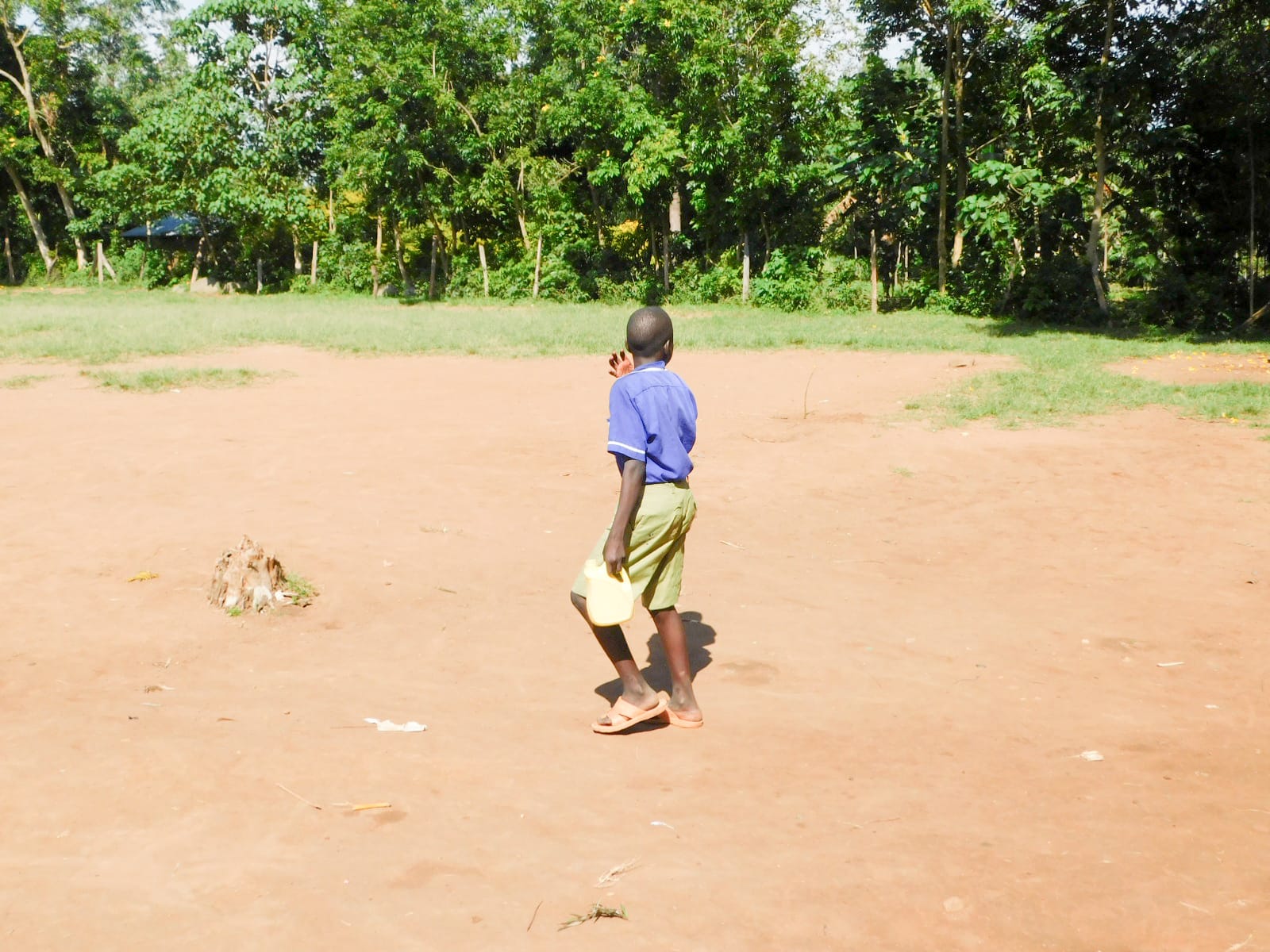August, 2019: Eshiakhulo Primary School Project Complete!
Eshiakhulo Primary School in Kenya now has access to a new source of safe, clean water thanks to the completion of their rain tank, which has the ability to collect 50,000 liters of water. We installed new latrines for students, handwashing stations, and we trained students and staff on improved sanitation and hygiene practices. All of these components work together to unlock the opportunity for these students to live better, healthier lives.

Rain Tank
Construction for this 50,000-liter rain tank was successful!

Parents, staff, and students helped our artisans gather everything needed for construction. The pupils did their part in assisting the artisans by providing water the whole time that they were working. All the while, women cooked meals for the artisans, and the school provided accommodations for the artisans during their work. Local men and women helped our artisans with their manual labor, too.

Students bring water for construction

Sinking and reinforcing the latrine pits
The process officially began with our staff and school administration looking around the school compound to try and determine the best location for a new rain tank. This needed to be the best site with good, clean roofing to catch the rainwater.

Preparing the tank foundation
Then, we cleared the site: excavating the soil within the required measurements to make level ground for the tank foundation. The foundation was cast by laying hardcore on level ground and then reinforcing it using steel, concrete and waterproof cement.
Both the drawing pipe as well as the washout pipe were affixed as the foundation was laid. The wall was built with ferro-cement techniques through 6 layers. The inner wall was plastered while rough casting was done on the outer part. Finally, the catchment area was dug, plastered, and a staircase installed.

Latrine construction underway

Tank walls going up
Dome construction could begin after the superstructure had been given enough time to settle. The manhole cover was fitted, inlet pipes were connected to the roof gutters, inlet screens, ventilation pipes (breathers) and overflow pipes were all done to standard.

Dome construction
Once finished, the tank was given 3 to 4 weeks to undergo complete curing before it was cleaned and handed over to Eshiakhulo Primary School, though we will continue to offer them unmatchable support as a part of our monitoring and maintenance program.

Digging the drainage area
When we officially handed over the project to the school, the Head Teacher Mr. Joshua Obuko expressed his joy about the water project and said that he never imagined he would have such a project at this school. He said the pupils and teachers had experienced hard times in the past due to water scarcity, but that he was optimistic of much improvement in matters of sanitation and hygiene as well as in academic performance from that day forward.


W salute for water!
The celebration was a great chance for us to acknowledge the school administration and students as the primary parties entrusted with the tools we’ve given, as well as remind them of our continued support as they develop. The pupils were very grateful because now they know that the burden of carrying water to school is a concern of the past. They were so excited to start using the rain tank once the heavens opened for the rains.

"I really appreciate the water project [as] such a blessing. We have really suffered water scarcity in this school [before]...We would like to thank [you] for blessing us with the project - may God bless you," Joshua said.

School staff join the fun
VIP Latrines

Completed girls' latrines
This project funded the installation of 6 new ventilated improved pit (VIP) latrines. All of these new latrines have cement floors that are designed to be easy to use and clean. And with a rain tank right on school property, there should be enough water to keep them clean.

Completed boys' latrines
Handwashing Stations
The 2 handwashing stations were delivered to the school and handed over to the Child to Child health club. These were placed outside of the girls’ and boys’ latrines to encourage handwashing after latrine use.

Ready for handwashing!
Health club members teach other students how to properly wash their hands at the stations, make sure the stations are filled with water and work to ensure that there is always soap or ash available.
New Knowledge
Hygiene and sanitation training was scheduled with the help of the school principal and the Head Teacher, Mr. Joshua Obuko, who together ensured that the training date would be convenient for students, staff, and parent representatives. Individual teachers helped by selecting students from each class to represent the others.

Training begins
Some 32 participants attended training, including 20 students from 4 different grades. Attendance was as expected and well-planned thanks to the Head Teacher's early preparation and recruitment for the training date. The weather on this particular day of training was sunny and hot in the morning, and then it turned cloudy and hinted of rain in the afternoon. We conducted most of the training in a classroom that was well ventilated and conducive for the training, however, thus helping to make it a success.

Trainer Lynnah in action
A number of topics were covered, including personal hygiene such as bathing, oral hygiene, and handwashing with soap as a barrier from germs; and operation and maintenance of the new facilities, with each person understanding their role for long-lasting clean water and good health. The new student health club will be greatly involved in project management and will be responsible for encouraging good health and hygiene practices amongst their peers, teachers, and the larger community.

Dental hygiene training
The attendees were actively involved in the training by asking and answering questions. For example, when we asked them to identify the ways which one can improve their hygiene and sanitation, the pupils mentioned things like washing hands before handling food, washing hands after visiting toilet, washing and disinfecting the toilets, and striving to always drink clean and safe water always to avoid diseases such as typhoid and diarrhea.
However, when we asked the students whether they practice all the habits they mentioned, they denied it and said they have had a big problem with water scarcity in their school which had exposed them to severe attacks of typhoid. All the attendees were interested in this topic since they all seemed to be affected by the discussion.

Group discussion
"We are glad we are not going to suffer from typhoid anymore," said 15-year-old student Valentine Ondeche.
The first memorable topic during training was about water pollution as we noticed that the trainees were cautious about water contaminants. We noticed this when one of the boys by the name of Eli asked how one may tell whether water is contaminated or not because the water may seem clean and yet it is contaminated.
We told the pupils to be keen about water contaminants right away, from the moment they collect water from the tank to the storage and drinking of it. The pupils admitted that they have not been keen about keeping water storage and drinking containers clean, a critical point where clean water is often unknowingly contaminated.

Handwashing training

Training on how to use and manage the tank
The second memorable topic during training was about personal hygiene. We asked the pupils which personal items are not supposed to be shared. Students mentioned items such as towels, socks, underclothes, and soap.
What made this special was that the pupils said they are used to sharing these items with siblings at home, even though it is not best practice, due to inadequate access to these items. While we knew they still faced challenges in accessing these items, their knowledge of this topic assured us that given the chance, they will do everything they can to improve their personal hygiene.

Thank you for making all of this possible!



 Rainwater Catchment
Rainwater Catchment
 Rehabilitation Project
Rehabilitation Project













































